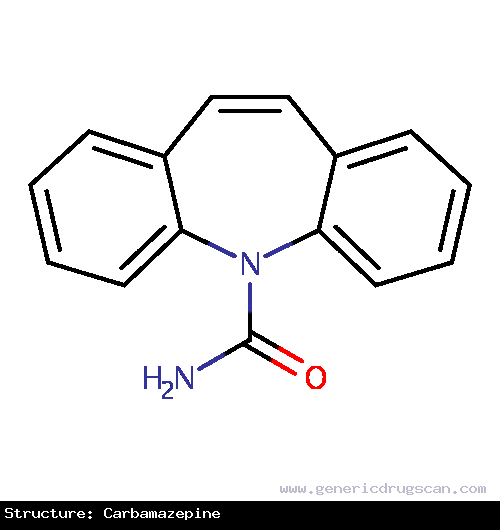Carbamazepine Drug: Indication, Dosage, Precaution, Side Effect , Storage, Category Type and corresponding Brands - www.genericdrugscan.com
Carbamazepine
Drug Status in USA : ApprovedDrug Status in Canada : Approved
pronunciation
pronounced as (kar ba maz' e peen)
Why is this medication prescribed?
Carbamazepine is used alone or in combination with other medications to control certain types of seizures in patients with epilepsy. It is also used to treat trigeminal neuralgia (a condition that causes facial nerve pain). Carbamazepine extended-release capsules (Equetro brand only) are used to treat episodes of mania (frenzied, abnormally excited or irritated mood) or mixed episodes (symptoms of mania and depression that happen at the same time) in patients with bipolar I disorder (manic-depressive disorder; a disease that causes episodes of depression, episodes of mania, and other abnormal moods). Carbamazepine is in a class of medications called anticonvulsants. It works by reducing abnormal electrical activity in the brain.
How should this medicine be used?
Carbamazepine comes as a tablet, a chewable tablet, an extended-release (long-acting) tablet, an extended-release capsule, and a suspension (liquid) to take by mouth. The regular tablet, chewable tablet, and liquid are usually taken two to four times a day with meals. The extended-release tablet is usually taken twice a day with meals. The extended-release capsule is usually taken twice a day with or without meals. To help you remember to take carbamazepine, take it at around the same times every day. Follow the directions on your prescription label carefully, and ask your doctor or pharmacist to explain any part you do not understand. Take carbamazepine exactly as directed. Do not take more or less of it or take it more often than prescribed by your doctor.
Swallow the extended-release tablets whole; do not split, chew, or crush them. The extended-release capsules may be opened and the beads inside sprinkled over food, such as a teaspoon of applesauce or similar food. Do not crush or chew the extended-release capsules or the beads inside them.
Shake the liquid well before each use to mix the medication evenly.
Your doctor will start you on a low dose of carbamazepine and gradually increase your dose.
Carbamazepine may help control your condition, but will not cure it. It may take a few weeks or longer before you feel the full benefit of carbamazepine. Continue to take carbamazepine even if you feel well. Do not stop taking carbamazepine without talking to your doctor, even if you experience side effects such as unusual changes in behavior or mood. If you have a seizure disorder and you suddenly stop taking carbamazepine, your seizures may become worse. Your doctor will probably decrease your dose gradually.
What are the precautions to be followed?
Before taking carbamazepine,- tell your doctor and pharmacist if you are allergic to carbamazepine, amitriptyline (Elavil), amoxapine (Asendin), clomipramine (Anafranil), desipramine (Norpramin), doxepin (Adapin, Sinequan), imipramine (Tofranil), nortriptyline (Aventyl, Pamelor), other medications for seizures such as phenobarbital (Luminal, Solfoton) or phenytoin (Dilantin), protriptyline (Vivactil), trimipramine (Surmontil), or any other medications.
- you should know that carbamazepine is the active ingredient in several products that have different names and may be prescribed to treat different conditions. Check the list of brand names at the beginning of this document carefully. All of the products listed contain carbamazepine and you should not take more than one of them at the same time.
- do not take carbamazepine if you are taking monoamine oxidase (MAO) inhibitors, including isocarboxazid (Marplan), phenelzine (Nardil), selegiline (Eldepryl), and tranylcypromine (Parnate), or have stopped taking them within the past 2 weeks.
- tell your doctor and pharmacist what other prescription and nonprescription medications, vitamins, and nutritional supplements you are taking or plan to take. Be sure to mention any of the following: acetaminophen (Tylenol); acetazolamide (Diamox); alprazolam (Xanax); anticoagulants ('blood thinners') such as warfarin (Coumadin); antidepressants such as amitriptyline (Elavil), bupropion (Wellbutrin, Zyban), buspirone (BuSpar), citalopram (Celexa), clomipramine (Anafranil), desipramine (Norpramin), fluoxetine (Prozac, Sarafem), fluvoxamine (Luvox), mirtazapine (Remeron), nortriptyline (Pamelor); antifungals such as itraconazole (Sporanox) and ketoconazole (Nizoral); cimetidine (Tagamet); cisplatin (Platinol); clarithromycin (Biaxin); clonazepam (Klonopin); clozapine (Clozaril); cyclosporine (Neoral, Sandimmune); dalfopristin and quinupristin (Synercid); danazol (Danocrine); delavirdine (Rescriptor); diltiazem (Cardizem, Dilacor, Tiazac); doxorubicin (Adriamycin, Rubex); doxycycline (Vibramycin); erythromycin (E.E.S., E-Mycin, Erythrocin); felodipine (Plendil); haloperidol (Haldol); HIV protease inhibitors including atazanavir (Reyataz), indinavir (Crixivan), lopinavir (in Kaletra), nelfinavir (Viracept), ritonavir (Norvir, in Kaletra), and saquinavir (Fortovase, Invirase); isoniazid (INH, Nydrazid); levothyroxine (Levoxyl, Synthroid); lithium (Lithobid); loratadine (Claritin); lorazepam (Ativan); certain medications to treat malaria such as chloroquine (Aralen) and mefloquine (Lariam); medications for anxiety or mental illness; other medications for seizures such as ethosuximide (Zarontin), felbamate (Felbatol), lamotrigine (Lamictal), methsuximide (Celontin), oxcarbazepine (Trileptal), phenobarbital (Luminal, Solfoton), phensuximide (Milontin) (not available in the US), phenytoin (Dilantin), primidone (Mysoline), tiagabine (Gabitril),topiramate (Topamax), and valproic acid (Depakene, Depakote); methadone (Dolophine); nefazodone; niacinamide (nicotinamide, Vitamin B3); propoxyphene (Darvon); praziquantel (Biltricide); quinine; rifampin (Rifadin, Rimactane); sedatives; sleeping pills; terfenadine (Seldane) (not available in the US); theophylline (Theobid, Theo-Dur); tramadol (Ultram); tranquilizers; troleandomycin (TAO); verapamil (Calan, Covera, Isoptin, Verelan); and zileuton (Zyflo). Many other medications may also interact with carbamazepine, so be sure to tell your doctor about all the medications you are taking, even those that do not appear on this list. Your doctor may need to change the doses of your medications or monitor you carefully for side effects.
- if you are taking any other liquid medications, do not take them at the same time as carbamazepine liquid.
- tell your doctor what herbal products you are taking, especially St. John's wort.
- tell your doctor if you have or have ever had glaucoma; psychosis; or heart, kidney, thyroid, or liver disease.
- you should know that carbamazepine may decrease the effectiveness of hormonal contraceptives (birth control pills, patches, rings, injections, implants, or intrauterine devices). Use another form of birth control while taking carbamazepine. Tell your doctor if you have unexpected vaginal bleeding or think you may be pregnant while you are taking carbamazepine.
- tell your doctor if you are pregnant or plan to become pregnant. Carbamazepine may harm the fetus. If you become pregnant while taking carbamazepine, call your doctor immediately.
- do not breast-feed while you are taking carbamazepine.
- if you are having surgery, including dental surgery, tell the doctor or dentist that you are taking carbamazepine.
- you should know that carbamazepine may make you drowsy. Do not drive a car or operate machinery until you know how this medication affects you.
- remember that alcohol can add to the drowsiness caused by this medication.
- you should know that your mental health may change in unexpected ways and you may become suicidal (thinking about harming or killing yourself or planning or trying to do so) while you are taking carbamazepine for the treatment of epilepsy, mental illness, or other conditions. A small number of adults and children 5 years of age and older (about 1 in 500 people) who took anticonvulsants such as carbamazepine to treat various conditions during clinical studies became suicidal during their treatment. Some of these people developed suicidal thoughts and behavior as early as one week after they started taking the medication. There is a risk that you may experience changes in your mental health if you take an anticonvulsant medication such as carbamazepine, but there may also be a risk that you will experience changes in your mental health if your condition is not treated. You and your doctor will decide whether the risks of taking an anticonvulsant medication are greater than the risks of not taking the medication. You, your family, or your caregiver should call your doctor right away if you experience any of the following symptoms: panic attacks; agitation or restlessness; new or worsening irritability, anxiety, or depression; acting on dangerous impulses; difficulty falling or staying asleep; aggressive, angry, or violent behavior; mania (frenzied, abnormally excited mood); talking or thinking about wanting to hurt yourself or end your life; withdrawing from friends and family; preoccupation with death and dying; giving away prized possessions; or any other unusual changes in behavior or mood. Be sure that your family or caregiver knows which symptoms may be serious so they can call the doctor if you are unable to seek treatment on your own.
What are possible side effects of this medication ?
Carbamazepine may cause side effects. Tell your doctor if any of these symptoms are severe or do not go away:- drowsiness
- dizziness
- unsteadiness
- nausea
- vomiting
- headache
- anxiety
- memory problems
- diarrhea
- constipation
- heartburn
- dry mouth
- back pain
- confusion
- loss of contact with reality
- chest pain
- yellowing of the skin or eyes
- vision problems
Carbamazepine may cause other side effects. Call your doctor if you have any unusual problems while taking this medication.
How to store the medication and dispose it of after its use later?
Keep this medication in the container it came in, tightly closed, and out of reach of children. Store it at room temperature, away from excess heat and moisture (not in the bathroom). Throw away any medication that is outdated or no longer needed. Talk to your pharmacist about the proper disposal of your medication.
Drug Category/Class
- Analgesics, Non-Narcotic
- Antimanic Agents
- Carboxamide Derivatives
- Anticonvulsants
- Antiepileptics
- Nervous System
- Cytochrome P-450 CYP3A Inducers
- Cytochrome P-450 CYP2B6 Inducers
- Cytochrome P-450 CYP1A2 Inhibitors
- Cytochrome P-450 CYP1A2 Inducers
- Cytochrome P-450 CYP2B6 Inhibitors
- CYP2B6 Inhibitors (strong)
- Cytochrome P-450 CYP2C9 Inhibitors
- Cytochrome P-450 CYP2C9 Inducers
| Prescribed | For the treatment of epilepsy and pain associated with true trigeminal neuralgia. |
| Weight : | 236.2686 |
| Structure | Carbamazepine |
 | |
| Formula | C15H12N2O |
Carbamazepine has 159 Brands listed
Search Generic Drugs alphabetically
